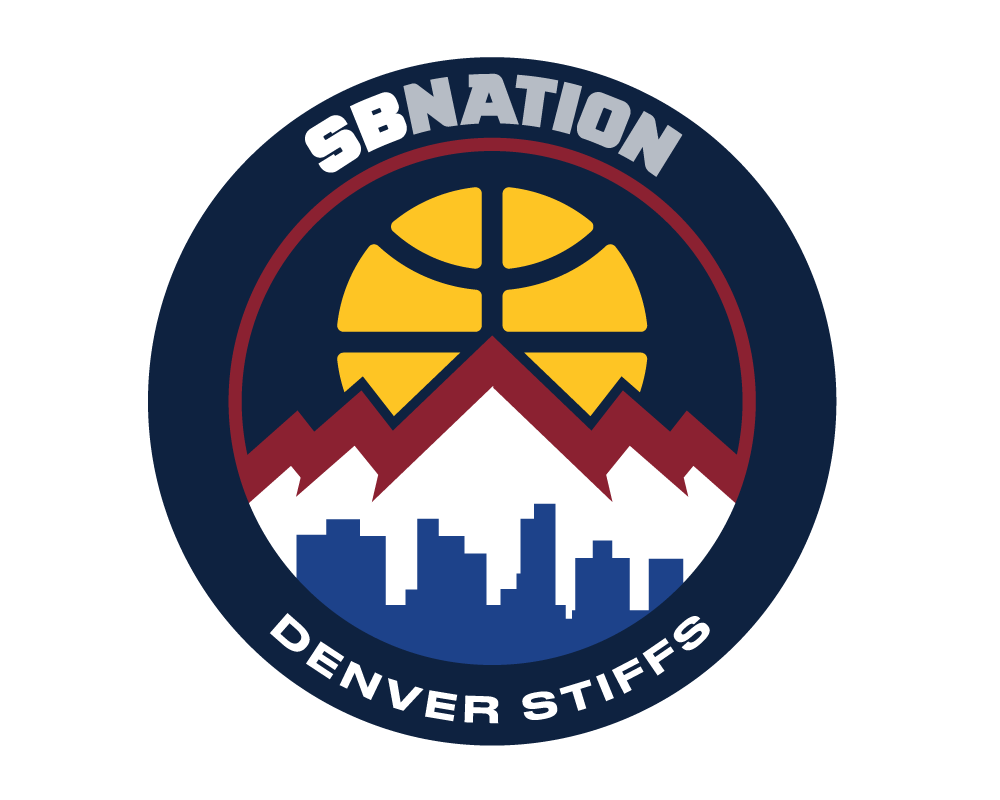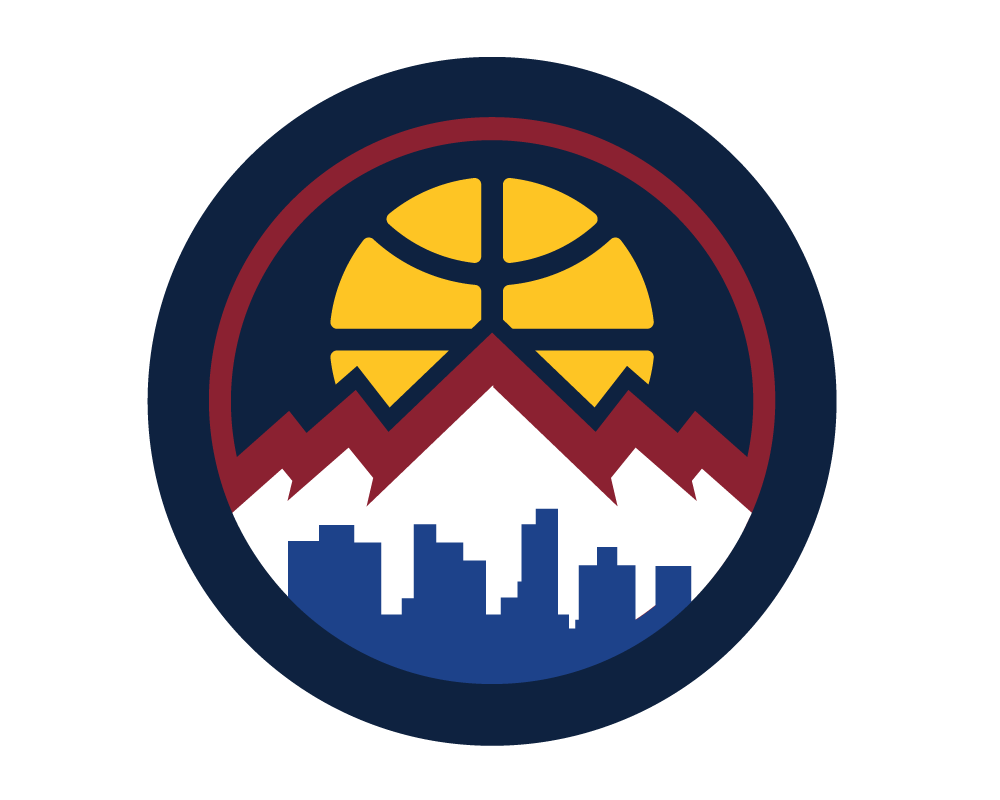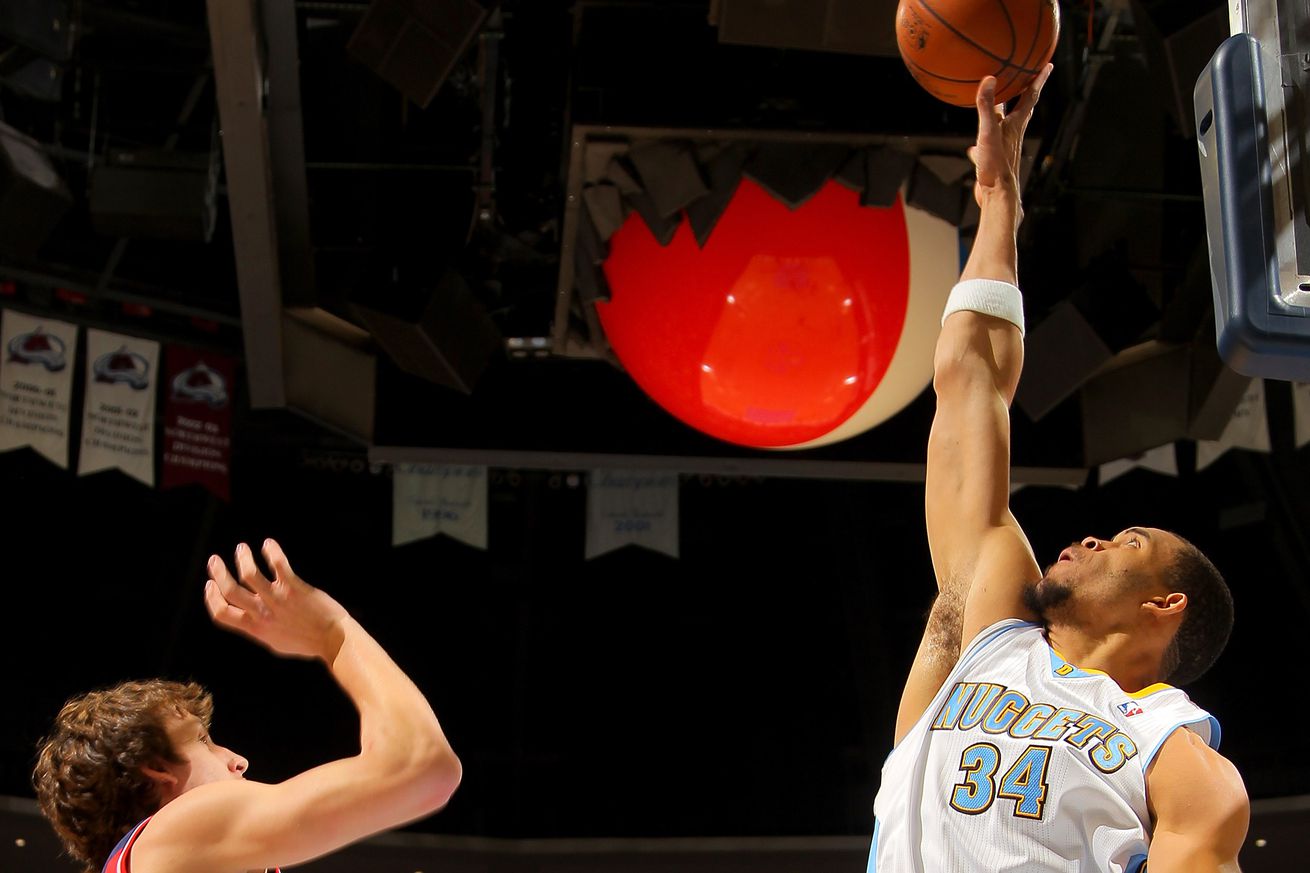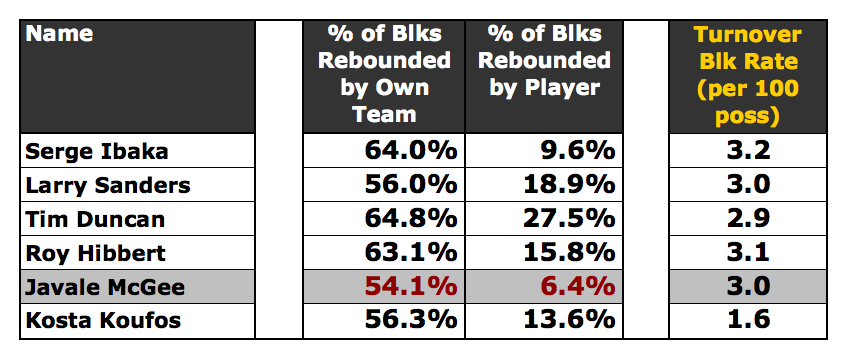While some see the potential for disaster in the likely starting role for Javale McGee next season, there are some huge positives in having an effective rim protector. This may mean any ‘gamble' on McGee could be well worth it for the chance to give Denver a true presence in the middle not seen since Marcus Camby or perhaps even the great Dikembe Mt. Mutombo (who once did this in the playoffs).
A Presence on the Inside
The value of having an inside presence on defense can be seen in the following graphic (by Kirk 'comic sans' Goldsberry) showing Shooting efficiency in the NBA. There is only one small area close to the rim where the shooting % climbs over 50 percent which Goldsberry calls "the most important tactical space" on the court.
In the diagram above the black semi-circle has a 9ft radius at the top and 8ft at its straight-line sides. Last season only 1 team in the NBA was able to make opponents miss more than half their shots within 8 feet, and that team was the Indiana Pacers with the rim protector Roy Hibbert (at 49%). On a positive note, the second ranked team on that list was the Nuggets who restricted opponents to 51.8%. But wait you say, the starting center for Denver last season was Kosta Koufos, so surely he must have been pretty good protecting the rim?
Well...not so fast. As the following chart shows Koufos lagged behind both Hibbert and McGee at the protecting the inside. Between 0-3ft he allowed opponents to shoot 3% better than McGee and a full 5% better than the 52.7% Hibbert restricted opponents to at the rim. He was also worse in the next zone 4-9ft than both McGee and Hibbert.
With Brian Shaw coming from Indiana to Denver there is potential for McGee to improve on his numbers if Shaw is able to implement a defensive scheme similar to that of the league best Pacers. The effectiveness of the rim protector based Pacers defense is further emphasized if we look at a chart breakdown of where opponents took their shots.
As can be seen, with Hibbert anchoring the middle and good perimeter defense, Indiana was able to force opponents to shoot less both closest to the rim (0-3ft in red), and also in the shot worth the most (the purple 3pt bars), effectively forcing more shots to be taken in the least efficient area (the 16+ft green bar).
If Brian Shaw can transfer some of this defensive efficiency to Denver (both at the rim and on the perimeter) the Nuggets may be on the way to a ‘playoff ready' defense.
McGee the shot blocker
Blocked shots are an imperfect measure of inside presence (as shots changed can be as important as shots blocked) but they can still offer valuable insight. Adding the top 3 blockers (by avg) in the NBA last season to the 3 centers looked at above we get the following block chart:
Going by these stats things look pretty good for McGee. While McGee is only ranked 8th in the league at 2 blocks per game he averaged significantly less time per game than others at only 18.1mins (he is the only player in the NBA blocks official league leaders top 20 to average under 20mins a game). In fact on a per possession basis McGee tops them all.
However not all blocks are equally effective. In the following clip McGee pulls off a monster block on Bogut, but before you can even sit back down in your seat, Curry has recovered the ball bamboozled Lawson and dished back to Bogut for the open slam (after McGee and Koufos, in a rare moment playing together get confused and both move to help on Curry penetrating).
The point here is that blocks that don't lead to a turnover are much less effective than those that do even though they count the same in the box score. Fortunately nbawowy has further stats on blocks that allow deeper analysis.
This second chart shows the % of blocks by a player that were recovered by any player on the defensive team, so completing a turnover. It also shows a subset of this, the % that were recovered by the player doing the blocking. I have then calculated a new statistic from this information:
TURNOVER BLOCK RATE = [ (Total Blks x % Rebounded by team)/Total Def possessions x 100]
This gives a true picture of the most effective blockers by giving the rate (per 100 possessions) at which a player is generating blocks that result in a turnover.
There are a number of interesting observations from this second chart:
- The players with the highest block rates from the first chart, McGee and Sanders, have lower % rates in blocks rebounded by team indicating they have more ‘empty' blocks than the others featured
- Ibaka and Duncan have the highest % rates in blocks rebounded by team but do it in different ways. Duncan recovers over 27% of his own blocks (indicating likely more ‘tip blocks' to himself) while Ibaka recovers less than 10% of his own blocks despite 64% being recovered by his team (indicating he is very proficient in ‘directing' blocks to his own players)
- If we rank by Turnover Block Rate, the league leader in blocks Serge Ibaka still comes out on top but Hibbert jumps to 2nd and McGee ties with Sanders for 3rd position
The other factors that jump out (perhaps since I highlighted them in red) are that McGee has the lowest marks in both the % categories of the players shown. This indicates two possible areas that McGee could improve his blocking effectiveness: either by making more of an effort to ‘direct' blocks to his own players or trying to increase the amount of tip blocks to himself he performs. However the first suggestion could be very dangerous for Denver players, just ask Corey Brewer, and the second suggestion goes against McGees natural spiking block style so may take some time to learn (or he could just catch more blocks I guess).
Another possibility that could improve McGees effectiveness which may show up in his stats is changing where he makes blocks. This possibility links to the influence of Brian Shaw and a change to a more Indiana style defensive scheme.
Using charts from nbawowy we can compare the spread of blocks by McGee and Hibbert spatially (click on charts for larger version).
We can immediately see a high concentration close to the rim for both players, and that McGee seems to have a larger 'blocking range' area than Hibbert.
This seems positive for McGee but may actually not be a good thing for defensive effectiveness. Hibbert has no blocks on 3pt shots while McGee has five. However since on average 2/3 of 3pts miss and in addition none of the five 3pter blocks McGee made resulted in turnovers these aren't particularly valuable blocks. While those five blocks may not seem like much overall there were also all the possessions that McGee may have extended or challenged defensively out at the 3pt line and did not get a block, which can create further defensive issues. Extending the defensive range of your center out to the 3pt line can leave them out of position for defensive rebounds/blocking out and can also lead to play such as the ‘runby' which McGee performed a number of times last season.
In this example Ginobili has passed from the far side of the court while flying out over the baseline to Leonard open in the weakside corner.
- In the first frame shown Leonard is already in his shooting motion while McGee is just leaving the paint (already giving him no chance to contest the shot in time).
- However instead of turning back to the hoop to look for the potential rebound McGee begins a ‘runby'. This consists of him running (no jump is involved) toward Leonard with his arm in the air giving at best the illusion of a challenge.
- As can be seen in the third frame McGee then turns in front of Leonard and keeps on running.
- By the time the ball is at the rim he has already passed the sideline referee on his way upcourt.
If Brian Shaw can implement and emphasis the rim protector role for McGee next season then McGee contesting (or puesdo-contesting) long 2s and 3pters can be cut right back as that will not be in his defensive role, and the runby may disappear.
Then playing more as a rim protector who defensive range extends only to around 16ft instead of out to the 3pt line (with the perimeter defensive responsibilities fully assigned to other players) McGee's block chart could start to look more like Hibbert's (with a corresponding change in stats).
Conclusion
While McGee has yet to reach his sky-high potential in the NBA, he has steadily improved his play since coming to the Nuggets, and by all accounts will be given every opportunity to succeed in Denver next season. If Brian Shaw is able to transfer enough of the defensive philosophy he assisted with in Indiana and can connect with McGee to help further unlock his potential, Denver may truly have one of the most intimidating rim protectors in the NBA and be a real chance to ‘make some noise' in the playoffs next season.
References: charts and graphs prepared by sensemaking with data taken from nbawowy.com and nba.com/stats, ‘Overall NBA shooting' chart by Kirk Goldsberry.











